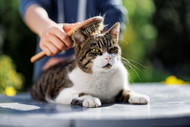Hairballs in cats
27th Aug 2024
Hairballs (or furballs, as they are sometimes referred to) in cats are common, especially during the seasons when your cat is moulting.
They form when your cat grooms themselves. Your cat’s tongue has tiny backwards facing barbs on it, that pick up stray hairs as they groom themselves. This is great for matts but also means your cat will end up swallowing some of the hair.
The majority of the hair will pass through your cat’s digestive system, to be expelled in the faeces, without causing any problems. But if some of the hair sits in your cat’s stomach, this can then form hairballs.
Are some cats more likely to get hairballs?
Hairballs are more likely to appear in cats with long coats. The thicker your cat’s fur and the more your cat grooms themselves, the more likely they are to get hairballs.
Kittens are less likely to get hairballs than adult cats. This is partly because kittens generally shed less fur and also because as cats get older, they become more competent and accomplished groomers. But unfortunately, this means they become more prone to getting hairballs, which can mean more for you to clean up! Not only can this unpleasant for both you and your cat, but worse still, this can cause gastrointestinal blockages.
Older cats continue to get hairballs as they did when they were younger. However, as your cat ages, the movement of food through their digestive tract will slow down, which can cause your cat to become constipated.
If your cat becomes constipated, it’s best to get them checked by your vet. If they are unable to pass whatever is in their digestive tract, hairballs and potential blockages may cause complications.
Symptoms
Symptoms and signs that your cat has hairballs may include hacking and coughing, gagging or retching. This is normally followed by them bringing up a small tube-shaped ball of hair.
Other signs you may notice include, nibbling on grass, Lethargy and Constipation. They may also experience a loss of appetite, making them less eager to eat, or eat less than they normally would.
Prevention and Treatment
It is important to treat and prevent hairballs to stop your cat from getting gastrointestinal blockages and becoming ill. Brushing your cat daily can help reduce the amount of hair your cat ingests when grooming themselves. You can also help by using a hairball supplement.
Purrform’s hairball supplement contains natural fibres such as Psyllium husk and chicory. These fibres will help your cat digest and reduce hairballs, which in turn, helps them pass them more easily.
Can Wildcats get Hairballs?
Big cats like lions and tigers aren’t particularly prone to hairballs in the same way as smaller cats, even though they have similar grooming routines to domestic cats. However, when they do develop them, this can become a BIG problem.
In recent years, both a lion and a tiger have developed hairballs four pounds in size, which unfortunately, had to be surgically removed, as they were so big.
Smaller wildcats in captivity may be more prone to hairballs, as their diet may include commercial foods, which can be too high in carbohydrates and lack sufficient moisture content. Some experts believe these processed food diets might contribute to digestive conditions, leading to hairballs.
Here at Purrform we pride ourselves on providing your cat with a high protein, grain free, species appropriate raw diet, to ensure natural and nutritional meal times and a healthy, happy cat!
